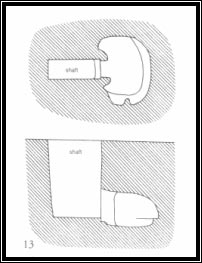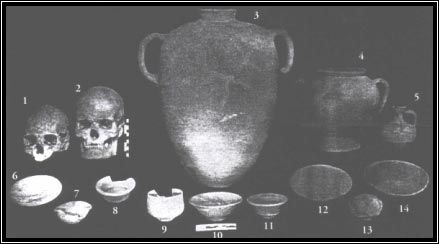At Tal-Bloq
At Tal-Bloq in Għajn Tuffieħa, a rock-cut tomb was accidentally discovered, but it is not stated if the tomb was preserved or not.
The Tal-Bloq rock-cut tomb is situated in farm house and was discovered in October 1961, probably by the owner of the farm house. Its orientation was not stated and probably was cut in the rock. It had a rectangular plan and it had an unusual shape as its side jutted into the chamber. Its sill was formed by two steps leading down to the chamber floor. Its chamber had a roughly rectangular plan and it had a shelf that ran from the right side near the entrance along the back, tapering into the left wall. On the right side of the tomb a small dividing wall was left, which formed a compartment near the entrance.1
The tomb contained a number of pottery items and they included a Punic amphora, with potter’s mark and had a small opening, broad shoulders, large fine handles and it tapers towards the base. There was also a cinerary urn with long handles set low on the shoulder and stretching below the middle of the vessel.


The vessel contained cremated remains and it probably had a cover. The third pottery item was a small jarlet with cupped mouth and biconical body. Other items included a bowl with a carinated low on the body and a flaring rim. There was also a bowl, straight and near vertical walls, a flaring rimmed bowl, a carinated bowl, a plate, another bowl, another plate, a damaged bowl, and a double-nozzled lamp with rolled rim and sharply pinched spouts. A number of corpses were found who included the remains of three male were found in the tomb, aged 25-30 years, two females aged 50 years and 60 plus years and cremation remains.
The tomb was probably cut between the years 300 BC onwards and re-used several times.2
References:
1 Claudia Sagona, Ancient and Eastern Studies: The archaeology of Punic Malta, Peetars, Belgium, 2002, p 818.
2. Ibid.
Researched and Written by: Charles Debono B.A.(Hons) History